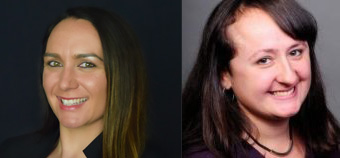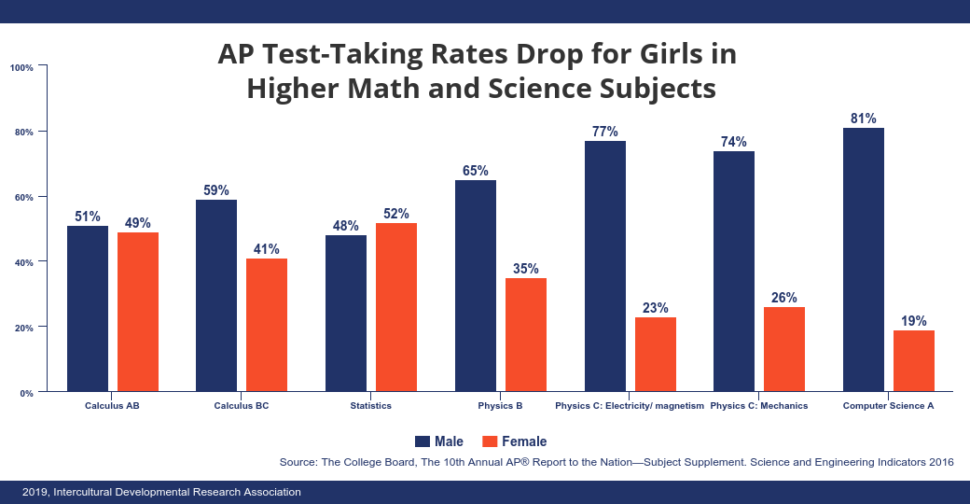• by Stephanie García, Ph.D., & Kasia Razynska • IDRA Newsletter • May 2019 •
 Girls’ involvement in K-12 mathematics has increased over the last 20 years. These improvements increase girls’ math aptitude, which directly relates to college access. Sadly, girls are still less likely to take higher level math courses in high school or choose STEM fields in college. This article reviews current trends in data and best practices for increasing girls’ performance and persistence through K-12 math.
Girls’ involvement in K-12 mathematics has increased over the last 20 years. These improvements increase girls’ math aptitude, which directly relates to college access. Sadly, girls are still less likely to take higher level math courses in high school or choose STEM fields in college. This article reviews current trends in data and best practices for increasing girls’ performance and persistence through K-12 math.
Today, women earn 42% of bachelor’s degrees in math. This rate has actually decreased by 4 percentage points in the last two decades. Among women of color, Latinas account for just 3% of math degrees, and Black women account for 2% of math degrees (NSF, 2019). Women make up almost half of the workforce, but only a quarter of women fill well-paid professions requiring math skills.
Females and males take Advanced Placement exams at roughly the same rates in calculus AB, statistics and chemistry (NSF, 2016). But females are less likely to take higher level AP exams, such as calculus BC, physics B and physics C (see graph on the next page). And when they head to college, women are much less likely to enroll in STEM fields. In 2014, only 8% of female high school graduates chose STEM fields in college, compared to 27% of males (NSF, 2016).
What can we do to help promote more female mathematicians? Jane Hutchison, M.P.P., of the Math Brain Lab at Georgetown University suggests removing stereotypes that reinforce negative ideas about girls’ capabilities (2018). Other research-based best practices as adapted below from the IES guide, Encouraging Girls in Math and Science, can help put girls on a path to math success (2007).

Teach Students that They Can Expand and Improve their Math Abilities
Sometimes students believe negative things others say about their intelligence or that they will never be good at math (Delpit, 2012). Schools and parents should encourage an asset-based mindset that expands abilities in math for all students (Johnson, 2014). Math gains in school usually coincide with high levels of student social support. This is true when teachers advocate “for the young people within a system that may not be so caring” (Delpit, 2012).
Students thrive with teachers who maintain high expectations and encourage their abilities in math. Teachers should also encourage students, especially girls of color, that their abilities in math will grow over time. By showing students they can improve, teachers help them build confidence to face difficulties and setbacks.
Provide Prescriptive, Informational Feedback
Providing timely and specific feedback boosts student success, ownership for learning, and confidence. Moreover, teachers should make sure to fully answer girls’ questions when giving feedback. Including specific math strategies within feedback can also support individual or group effort and the overall learning process.
Math teachers should give constructive, meaningful feedback that leads to multiple opportunities for students to revise their work (Krajcik, et al, 2016). For example, including positive comments as students try new things acknowledges their effort and increases self-confidence in their math abilities.
Girls in K-12 mathematics have equal abilities to succeed but need more space to do so. These five practices encourage girls to pursue math professions, thus helping to close the gender gap in math careers.
Expose Girls to Female Role Models Who Have Succeeded in Mathematics
Exposing girls to female role models assists in countering stereotypes and broadening understandings of possible math career pathways and applications. Women who have succeeded can share tips for “persistence, degree completion, and a robust mathematics identity” (Joseph, et al., 2017).
Parents and other community members can provide such opportunities outside of formal educational settings. Making role models visible helps students reject stereotypes. This holds great weight since negative stereotypes affect student performance and increase anxiety in stressful situations, such as tests (IES, 2007).
Spark Interest and Foster a Mathematics Identity
To build girls’ interest in math, teachers can create ways to leverage their interests, identity and sense of belonging. Math educators should embrace an authentic teaching approach that integrates culturally-relevant and responsive practices in the classroom. According to Joseph, et al. (2017), “A robust mathematics identity” builds persistence in math. This includes ensuring students have a positive self-concept and see how creative and relevant math is in their daily lives (Peart, 2018).
Likewise, educators should center math instruction on children’s assets and resources to “elicit the ways children know, use and learn mathematics” (Kalinec-Craig, 2017). Designing engaging classroom activities that include all students creates equitable opportunities that can spark long-term interest in mathematics (Johnson, 2016).
Connect Specialized Mathematics Skills to Real World Applications
Higher level math usually challenges students, regardless of gender. Students rarely question why they learn to read or write. They do ask why when learning math extends beyond basic arithmetic, unless connections to math’s real-world uses beyond the classroom are clear. Students are “caught up in learning standards and then being assessed on them” (Kitchen, et al., 2016).
Schools need to use relevant and rigorous curriculum designed to prepare girls to succeed in math professions. This increases critical thinking through real-world problems and engages students in specialized math skills (Hertzog, 2005; Li & Tsai, 2017). Project-based learning approaches encourage students to “apply knowledge learned to transferable domains” (Booker & Hoon Lim, 2018).
Girls in K-12 mathematics have equal abilities to succeed but need more space to do so. These five practices encourage girls to pursue math professions, thus helping to close the gender gap in math careers. They also foster girls’ skills and beliefs about their own abilities and perceptions about the role of women in these professions. If implemented effectively and consistently, these practices can improve the outcomes for all children regardless of gender, race, language or socio-economic status.
The IDRA EAC-South’s capacity-building technical assistance helps schools in the U.S. South address inequities and desegregation issues impacting sex and gender equity. Promoting sex and gender equity can ensure equal access to rigorous coursework, a healthier and safe learning climate, and high-quality teaching. More information is available at: https://www.idraeacsouth.org/gendersex.
Resources
Booker, K.C., & Hoon Lim, J. (2018). Belongingness and Pedagogy: Engaging African American Girls in Middle School Mathematics. Youth & Society.
Delpit, L. (2012). “Multiplication is for White People” –Raising Expectations for Other People’s Children. New York, N.Y.: The New Press.
Hertzog, N.B. (2005). Equity and Access: Creating General Education Classrooms Responsive to Potential Giftedness. Journal for the Education of the Gifted.
Hutchison, J. (December 19, 2018). Boys and Girls are Equally Equipped to Succeed in Math. Psychology Today.
Institute of Education Sciences. (2007). Encouraging Girls in Math and Science: IES Practice Guide. National Center for Education Research.
Johnson, P. (February 2016). STEM Pathways for Girls of Color: A Review of the Literature. IDRA Newsletter.
Johnson, P. (2014). How’s a picture worth 1,000 words in math and science, presentation slideshow. Intercultural Development Research Association.
Joseph, N.M., Hailu, M., & Boston, D. (2017). Black Womens’ and Girls’ Persistence in the P-20 Mathematics Pipeline: Two Decades of Children, Youth, and Adult Education Research. Review of Research in Education.
Kalinec-Craig, C.A. (2017). The Rights of the Learner: A Framework for Promoting Equity Through Formative Assessment in Mathematics Education. Democracy and Education.
Kitchen, R., Ridder, S.A., & Bolz, J. (2016). The Legacy Continues: “The Test” and Denying Access to a Challenging Mathematics Education for Historically Marginalized Students. Journal of Mathematics Education at Teachers College.
Krajcik, J., Blumenfeld, P.C., Marx, R.W., Bass, K.M., Fredricks, J., & Soloway, E. (1998). Inquiry in Project-Based Science Classrooms: Initial Attempts by Middle School Students. Journal of the Learning Sciences.
Li, H.-C., & Tsai, T.-L. (2017). The Implementation of Problem-Based Learning in a Taiwanese Primary Mathematics Classroom: Lessons Learned from the Students’ Side of the Story. Educational Studies.
National Science Foundation. (2019). Women, Minorities, and Persons with Disabilities in Science and Engineering. National Science Foundation.
Peart, D. (2018). Guiding Students to a Healthy Math Identity. Edutopia.
Stephanie García, Ph.D., is an IDRA education associate. Comments and questions may be directed to her via email at stephanie.garcia@idra.org. Kasia Razynska is associate director of evaluation and continuous improvement for the Mid-Atlantic Equity Consortium. Comments and questions may be directed to her via email at kasia@maec.org.
![]() [©2019, IDRA. This article originally appeared in the May 2019 IDRA Newsletter by the Intercultural Development Research Association. Permission to reproduce this article is granted provided the article is reprinted in its entirety and proper credit is given to IDRA and the author.]
[©2019, IDRA. This article originally appeared in the May 2019 IDRA Newsletter by the Intercultural Development Research Association. Permission to reproduce this article is granted provided the article is reprinted in its entirety and proper credit is given to IDRA and the author.]



